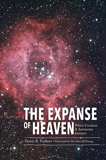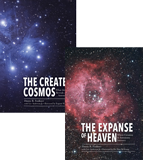Seeing Stars in a Young Universe
The Bible reveals that creation was about 6,000 years ago, so how can we see stars that are millions of light-years away?
On dark, clear evenings in late summer and early autumn, you can see the Milky Way as a faint, broad streak of light across the sky. You are looking at our galaxy, a collection of a few hundred billion stars. All the individual stars we can see are within our galaxy, at most a few thousand light-years away. Most stars in our galaxy are so far away that our unaided eyes see their dim light only collectively as the faint streak of the Milky Way.
In autumn, you can see something even more distant. The Andromeda Galaxy appears as a faint patch of light in the constellation Andromeda. It’s a galaxy like our Milky Way, but it looks tiny because it is so far away—about two million light-years.
For those who believe in biblical creation, this brings up an interesting and perplexing question. Since a light-year is the distance light travels in a year (about 6 trillion miles [9.5 trillion km]), and the Bible indicates that the creation was only a little more than 6,000 years ago, how can we see stars that are much farther away than 6,000 light-years? The stars we see with our naked eyes are within 6,000 light-years, so they shouldn’t be a problem. However, even the unaided eye can see the Andromeda Galaxy. And with telescopes, we can see many more distant galaxies. Creation scientists call this the light travel time problem.
Creationists have proposed many solutions. One suggestion is to doubt the great distances. But there are many good physical reasons to believe those distances are at least roughly correct. (For a detailed discussion, visit AnswersResearchJournal.org.)
An Appearance of History
Other creationists appeal to God’s creation of an instantly “mature” universe. Adam and Eve were created mature, as were many plants and animals. So perhaps, in a similar manner, God created light already in transit from distant stars, so it arrived on earth on day four, when God made the astronomical bodies.
The problem is that, according to this solution, light from anything farther away than about 6,000 light-years—that is, most of the universe—has never actually reached the earth, and probably never will. This raises the prospect that much of the universe need not even exist—all that matters is the light that implies it exists. In other words, much of the universe, including astronomical events such as supernovas that we observe and study today, is an illusion.
Decaying Light Speed
Another suggestion is that the speed of light has decreased since creation. Some people have interpreted slight variations in historical measurements of light speed as indications that light has slowed. They reason that if the speed of light were near infinite at the beginning, then light from all the universe could have arrived on earth on day four, but the speed of light has decreased tremendously since then.
However, all secular astronomers and virtually all creation astronomers agree that the data does not support this possibility. Furthermore, the speed of light depends on two fundamental constants that determine the structure of matter. If the speed of light changes, then everything else about the universe changes as well.
Relativistic Effects
Still other creationists have proposed different ways the problem can be explained by the strange effects of general relativity, the modern theory that time is relative to space and gravity. The speed with which time passes depends on your location. In most cases, the differences are miniscule. But proponents of this view argue that conditions were very different during creation week. Light could travel through much of the universe while only a day or so passed locally.
These compelling proposals also have some drawbacks, which are too technical to cover in a short article.
Another Alternative
Perhaps we need to look at the problem differently, from Adam’s perspective. The stars we see today with the naked eye are not a problem because 6,000 years have passed and all the visible stars in the Milky Way are within 6,000 light-years of earth. But this would not have been the case for Adam. God created Adam two days after he made the stars. That means starlight had only two days to reach the earth, but the closest star is more than four light-years away.
We need to recognize that God used many processes during creation week that are different from processes today.
How did Adam see stars the first evening of his life? He must have seen them because otherwise stars could not have fulfilled their function to help humans mark time (Genesis 1:14–18). So Adam had a light travel time problem. Perhaps we should attempt to solve Adam’s problem, not ours.
We need to recognize that God used many processes during creation week that are different from processes today. He didn’t make Adam instantaneously out of nothing, but instead formed him from the dust of the ground (Genesis 2:7). God used a similar process to make the land and flying animals (Genesis 2:19). And he caused the plants to grow rapidly out of the ground on day three (Genesis 1:11–12). In other words, God rapidly and miraculously matured many things during creation week. It seems both logical and theologically consistent that, in a similar manner, God could have rapidly “matured” the universe, bringing the light from distant objects to the earth in a way similar to trees instantly sprouting and rising to full height.
In addition to creating the physical universe during creation week, God also created the laws that govern it. What if these laws were not in full effect until the end of that week, as we see when God created mature plants, land animals, and the first two humans?
Instead of bringing starlight to earth according to physical laws, God could have miraculously solved the light travel time problem on day four, before putting the laws that govern light travel into effect. After all, nearly everything about creation was miraculous.
A Shining Truth
We know that the stars faithfully declare God’s glory (Psalm 19:1). Mystery is part of God’s majesty, since he infinitely surpasses our finite minds (see Deuteronomy 29:29). Our rebellious, sinful nature converts this wonder into doubt. But God designed mysteries into his universe to excite our wonder and curiosity, and ultimately our worship of him. In all our discussions, we need to point people beyond starlight to the problem that matters most and its solution in Jesus Christ.
Related Videos
Excerpt from Distant Starlight
Answers Magazine
November–December 2017
Dr. John Whitcomb explains the timeless truths that will help us reach the next generation with God’s message of redemption.
Browse Issue SubscribeRecommended Resources

Answers in Genesis is an apologetics ministry, dedicated to helping Christians defend their faith and proclaim the good news of Jesus Christ.
- Customer Service 800.778.3390
- © 2024 Answers in Genesis







